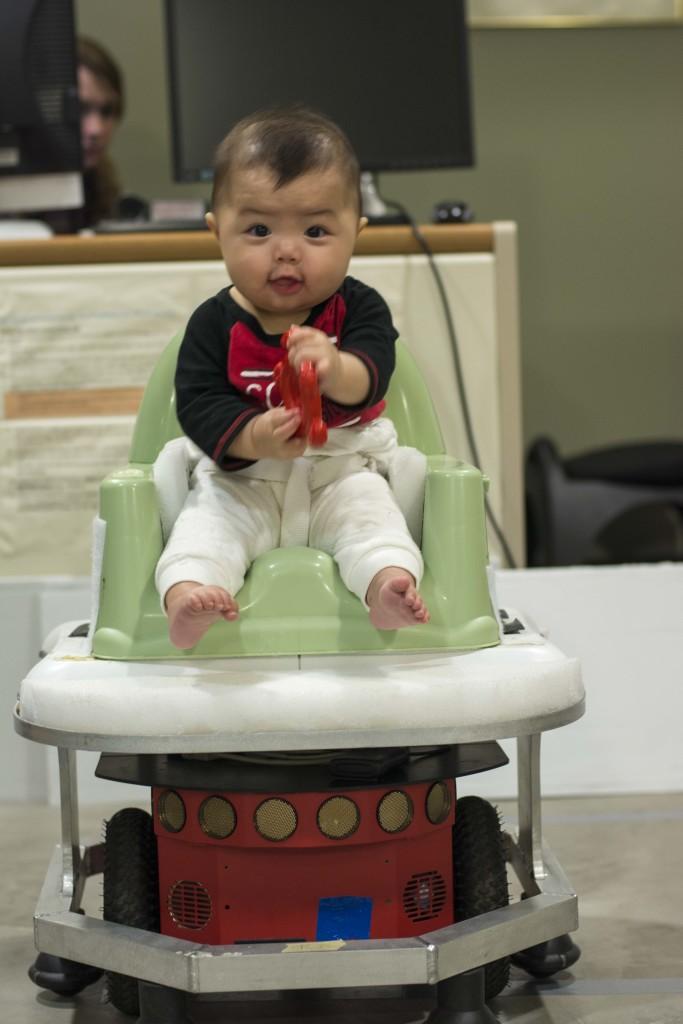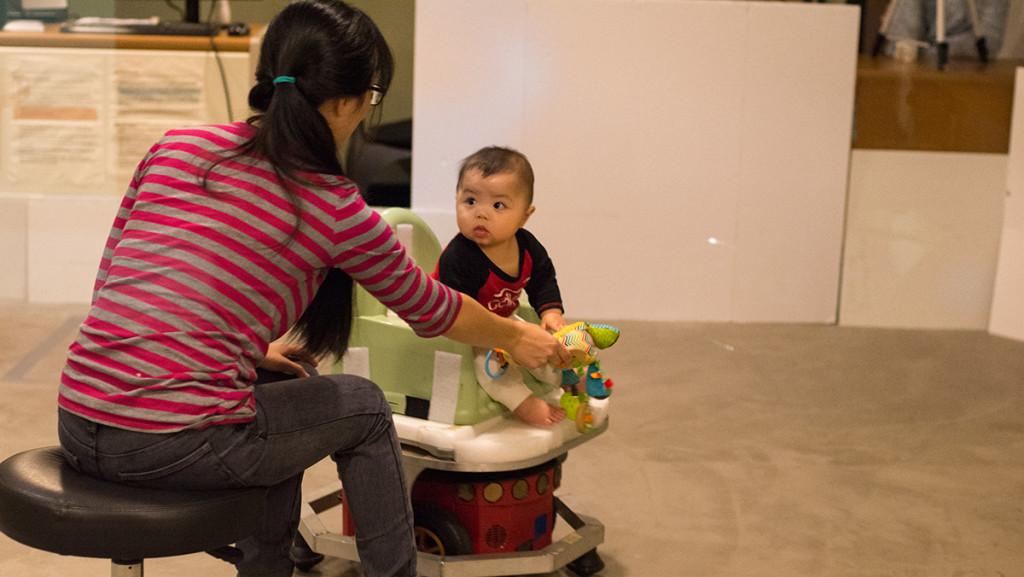Ithaca College professors and graduate students are demonstrating the benefits of providing wheelchairs to motor-impaired babies in an ongoing study called “Tots on Bots.”
Carole Dennis, professor in the Department of Occupational Therapy, and Sharon Stansfield, associate professor and chair in the Department of Computer Science, are nearing the end of their first session with 5-month-old infants, during which they studied the infants’ abilities to use a robotic wheelchair, Stansfield said.
Dennis and Stansfield purchased three robots with leftover grant money from a previous study, along with financial support from the deans’ offices of the Humanities and Sciences and Health Sciences and Human Performances schools, Stansfield said.
Dennis and Stansfield created the robotic wheelchair using the Pioneer 3-DX robots — which look like a box on wheels — and Wii Balance Boards. Dennis and Stansfield attached a Wii Balance Board to a flat surface on the top of the robots with a small seat for the baby. Sitting on top of the Wii Balance Board allows an infant to move around the room simply by leaning in the direction he or she wants to go. The Wii Balance Board is calibrated when the infant is sitting up straight and can sense extra pressure in any area of the board, Stansfield said. The robot has panels on the front that can sense other objects and stop before hitting them, Dennis said.

Stansfield said she wrote a program with her computer science students that allows the robot to communicate with a Wii Balance Board to determine which way the baby is leaning. Over the past five years, the team worked on perfecting the program. They also began studying infants’ abilities, including their ability to use a wheelchair with a joystick or switch control, Stansfield said.
Currently, most health care providers won’t pay for a wheelchair until the infant is at least 2 years of age, Dennis said. This is a problem because babies begin learning and expanding their thinking as soon as they can move. If one baby is restricted for a year longer than another, he or she will have different cognitive abilities, Dennis said.
“We have the sense that if we are able to demonstrate having the option to move makes a difference in one’s thinking abilities, that provides more evidence for why we should provide mobility options to babies with disabilities much earlier than we do now,” she said.
This robot is different from most wheelchairs used today for motor-impaired infants, Dennis said. She said the methods of control are easier than a joystick or switch. She also said the robot allows infants to be closer to their environment as opposed to other wheelchairs that are high above the ground and too bulky to allow for immersion.
The infants participating in the Tots on Bots study are typically developing babies, not motor-impaired, Dennis said. Their motor abilities are irrelevant to the study because the cases of motor-impairment vary greatly, Stansfield said.
“For motor-impaired children, each one is unique,” she said. “Our goal is to show that if you provide movement earlier for motor-impaired children, that it helps them with their cognitive development to stay at a level with their peers.”
Dennis and Stansfield have gathered students and faculty from all departments of the college to examine infants’ abilities to use a robot for mobility, Stansfield said. Some, like graduate student Julie Donner, joined the study to fulfill requirements for the occupational therapy five-year graduate program, she said. Donner said she chose the Tots on Bots study because of its unique objective.
“I just think it’s a cool concept of, in the future, kids with disabilities have the opportunity to be mobile at a very young age,” Donner said. “It’s just interesting seeing how infants’ behaviors are so different.”
Each infant attends 12 sessions over five or six weeks, Dennis said. Each session begins with three minutes of free play, followed by 10 minutes of directed reaching, in which infants are encouraged to take toys placed in front of them, and a final three-minute free play period, Dennis said.
After these 12 sessions, the babies will attend two sessions in the cognition lab with Nancy Rader, professor of psychology, Stansfield said. This will test executive function, which deals with an infant’s ability to plan activities and stop something from happening if necessary, she said. Few studies have been conducted on executive function at such a young age, and psychologists know little about when it begins, Dennis said.
As the 12 sessions come to an end, the team is preparing for another round before or after Thanksgiving break, Stansfield said. When the study is complete, the team hopes to publish its work and change the policy on when babies receive wheelchairs, Stansfield said.
“What it will also allow us to do is say, ‘We have new studies, which we have performed, which show that if you take an infant who is not mobile and give them mobility before they’re crawling, that mobility does contribute to their cognitive development,’” she said.








